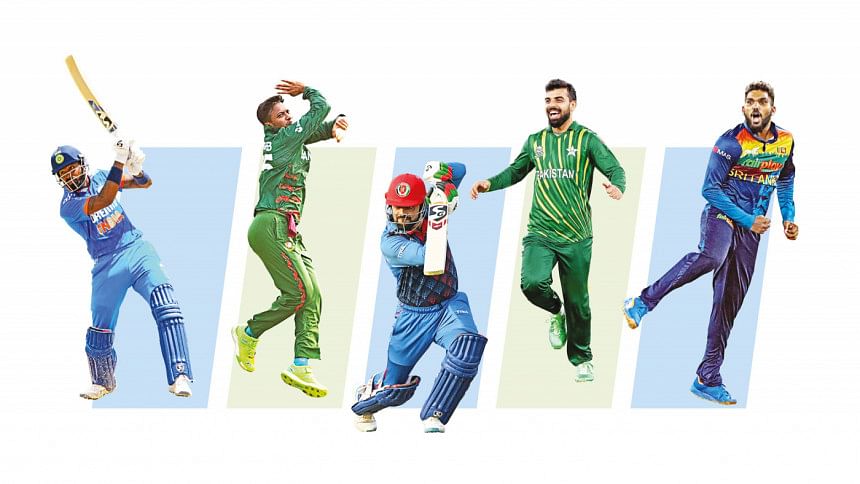All-rounders may hold the key

On the face of it, this should be a World Cup that suits South Asian teams. Pitches in the Caribbean have tended to be slow, in Guyana, Kingstown, and Antigua in particular.
If the trends seen in last year's Major League Cricket are any indication, surfaces in Dallas are likely to tend towards the slower side also. And in Lauderhill, Florida, only once has a team breached 190 in the six men's T20 Internationals played there this decade.
But this is a World Cup in which so little can be confidently predicted. So, few matches have been played in the three United States venues. Although drop-in pitches are being imported, and technically should play fairly evenly, there is no real telling how those tracks will fare in the particular climatic conditions that prevail in each of these venues, or how they will wear through the course of the tournament. New York is an especially tricky proposition. One month out, the stadium there is still being constructed.
With so much uncertainty about how the tournament will pan out, it could be the all-rounders in each squad that define teams' progress.
When a side turns up at the ground and the track looks like there will be some seam early on [particularly in the morning matches, some of which start as early as 10:30am local time], captains would ideally like to have a high-quality seam-bowling all-rounder to boost the fast-bowling stocks, while compromising little in the way of batting.
If, mid-tournament, the pitches begin to change after several matches have been played on the same square, teams with spin-bowling all-rounders may find themselves in advantageous positions, in terms of picking their XI.
Most South Asian sides have the spin-bowling all-rounder spot covered, of course. Bangladesh have Shakib Al Hasan, India have Ravindra Jadeja and Axar Patel, Sri Lanka have Wanindu Hasaranga, Afghanistan have Rashid Khan, and Pakistan have Shadab Khan. So good is South Asia at producing spin bowlers that can bat, that all these players would likely make it into the team based only on their bowling.
But when it comes to seam-bowling all-rounders, South Asian sides tend not to have as high-quality a production line. Sri Lanka, for example, have Dasun Shanaka and Angelo Mathews in their squad. Both are batting all-rounders, and limited bowlers -- Mathews can be effective with the new ball when there is seam and swing on offer, but struggles in the middle overs, and cannot really bowl at the death except in extreme circumstances. Shanaka prefers bowling a quiet over in the middle, but has been in poor hitting form over the past year.
India have Hardik Pandya, but he's coming off a rough IPL season, when for the first time in his career, he has faced the ire of India fans. Shivam Dube is also in the India squad, but at the international level, his bowling returns don't inspire a lot of confidence.
Pakistan are unlikely to pick any seam-bowling all-rounders. Afghanistan have the likes of Gulbadin Naib and Karim Janat. Again, these are players with only passable bowling statistics. Unlike the spinners, many of South Asia's seam-bowling all-rounders would not make the XI on one skill alone.
Unusually for a World Cup year, there has also not been an Asia Cup. This year the IPL has imposed itself in the months leading up to the global tournament. Many have noted that the Impact Player rule in the IPL has seriously disadvantaged all-rounders. How India pivots back to a competition in which they cannot call on ultra-specialists to take care of specific passages in the game, remains to be seen.
The counter to this, of course, is that South Asia perhaps has the finest seam bowling cohort it has ever sent to a World Cup. Bangladesh have Mustafizur Rehman and Taskin Ahmed. Pakistan have Naseem Shah and Shaheen Afridi. Sri Lanka have their fastest seam-bowling battery ever -- Dushmantha Chameera, Dilshan Madushanka and Matheesha Pathirana all capable of breaching 145kph. India, of course, have the most valuable quick of them all, Jasprit Bumrah, as well as Mohammad Siraj, who is likely to prosper when movement is on offer.
But at a tournament that involves so much travel between time zones, such a diversity of venues, and a huge variety of teams, versatility is likely to be key. How well can you fine-tune your strategy for this particular match? All-rounders may be key to that.
Andrew Fidel Fernando is a senior writer at ESPNcricinfo.

 For all latest news, follow The Daily Star's Google News channel.
For all latest news, follow The Daily Star's Google News channel. 



Comments